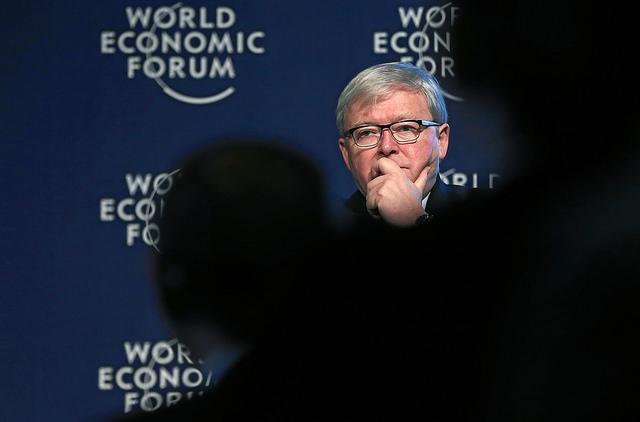
The Quad is more notable for the questions it provokes than the answers it offers.
The informal dialogue between the US, Japan, Australia and India is a discussion groping towards a grouping.
ASPI’s paper Quad 2.0: New perspectives for the revived concept notes that the second coming of the Quad ‘has become one of the most debated and contested ideas in current geopolitics’.
Much heat and light is directed at a small process—reborn in 2017—meeting informally at officials’ level, offering no formal statements or agreed view of the world.
The lack of answers emphasises the quality and quantity of questions about the Quad, a small beast grappling with big issues.
The man who sank Quad 1.0 when he was Australia’s prime minister, Kevin Rudd, illustrates that in his discussion of the big questions that caused his new government to pull out of the infant quadrilateral in 2008. A decade on, they’re still great questions.
Rudd published the second volume of his memoirs late last year, after the rebirth of Quad 2.0, and he devotes nearly two pages to his reasons for pulling Australia out of Quad 1.0.
The former prime minister gets stroppy about what he calls the ‘demonstrably false’ claim that he sank Quad 1.0 to appease China. When The Kevin gets stroppy, the details of the argument are piled on as the exasperated tone builds. Normally, exasperated Kevin builds his case with a central set of facts surrounded by statements of argument and conclusion.
In the case of the Quad, though, he fires off a barrage of questions about the historical baggage Japan and India have with China and the possibility of future zig-zags in the way New Delhi or Tokyo deals with Beijing. Plus, he muses on how a four-way alliance would impact on Australia’s bilateral alliance with the US.
Japan: Looking back at the 2008 debate, Rudd poses this question on Japan: ‘[W]hy would Australia want to consign the future of its bilateral relationship with China to the future health of the China–Japan relationship, where there were centuries of mutual toxicity? For Australia to embroil itself in an emerging military alliance with Japan against China, which is what the quad in reality was, in our judgment was incompatible with our national interest.’
India: While not as toxic as Sino-Japanese relations, Rudd writes, India and China had fought a violent border war in 1962 and still had thousands of square kilometres of disputed border regions that periodically erupted into violent clashes. ‘So did Australia want to anchor our future relationship with Beijing with new “allies” which had deep historical disputes still to resolve with China?’
Allying with Japan and India: ‘If the quad became formalised, where would that place Australia if we then had to take sides in Delhi’s or Tokyo’s multiple unresolved disputes with Beijing? A further danger we faced was, if Australia proceeded with the quad, what would happen if domestic political circumstances later changed in either Japan or India? Governments could change through elections. Even the policies of existing governments could change. Australia would run the risk of being left high and dry as a result of future policy departures in Tokyo or Delhi. Indeed, that remains a danger through to this day.’
The US alliance: Australia is already bound by what Rudd calls the ‘far-reaching’ provisions of the ANZUS Treaty to support the US in the event of an armed attack on US forces in the Pacific. ‘Strengthening a bilateral alliance is one thing’, he writes. ‘Embracing a de facto quadrilateral alliance potentially embroiling Australia in military conflict arising from ancient disputes between Delhi, Tokyo and Beijing is quite something else.’
For Rudd, the absence of a quad didn’t preclude strengthening bilateral security cooperation with India or Japan ‘outside the framework of any more binding set of quadrilateral treaty or sub-treaty arrangements’.
The former prime minister concludes with an attack on ‘sloppy analyses’ that he sank Quad 1.0 to ‘please Beijing’. Rudd writes that his government was ‘perfectly prepared to adopt a hardline approach towards Beijing whenever our national interests and values demanded it’, pointing to his approach to human rights and the China-sceptical language of Australia’s 2009 defence white paper.
As for Quad 2.0, that gets one sentence: ‘The extent to which political and strategic circumstances may have changed a decade later is another matter entirely.’
Another matter entirely! Such brevity from The Kevin tells you something about the perplexities and prospects of the reborn quadrilateral.
If times have changed, does that mean the answers to Rudd’s big questions have changed?
Perhaps we’ve moved beyond the loud ‘No!’ that Rudd gave to what he envisioned as a ‘de facto quadrilateral alliance’.
Now, the same prospect gets a faintly mumbled response that sounds something like: ‘Hmm. Well, perhaps. Maybe. Too early to say, really.’
It’s a long way from informal talks among officials to even a de facto form of alliance. Yet, as The Kevin says, political and strategic thinking has changed.
The questions Rudd poses about Quad 1.0 are equally fascinating today. Let’s summarise them into two monster posers for Quad 2.0 to ponder: What is China going to do? What must the US, Japan, Australia and India do together?